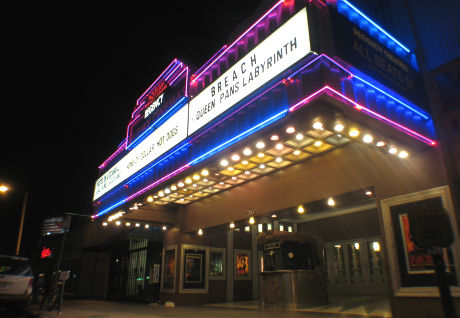I’m sorry, but there’s no rebooting The Hulk. The cord has been cut; the faith broken; the legend poisoned. It was killed by Hulk and its well-meaning but ill-suited director, Ang Lee. Anyone who tries to bring this concept back to life will know that it is now and forever accursed. Director Louis Leterrier thinks that by casting Ed Norton as Bruce Banner/The Hulk for a new go at the legend — an untitled Hulk flick that Universal will open in the summer of ’08 — that things will be different. Hah! The Movie Gods determine these things for reasons we can’t know, much less challenge. Go, Leterrier. Give it up, Norton. Thine efforts are surely doomed.
Day: April 15, 2007
Piaf = Cotillard
As biopics about self-destructive artists go, Oliver Dahan‘s La Vie en Rose — the sad story of French songbird Edith Piaf — is above-average. It screams “passion” from every pore, and delivers in the way a movie like this should — superb period atmosphere (World War I to early 1960s), handsome production values, fine ensemble acting, skillful editing and, for a film about a very intense and event-filled life, appropriately longish (140 minutes). But it is essential viewing for one reason and one reason only — Marion Cotillard‘s bracingly vivid, wholly convincing, almost mind-blowingly hardcore performance as Piaf.

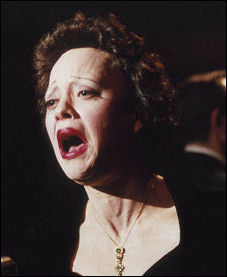
Marion Cotillard in A Good Year; as Edith Piaf in La Vie en Rose
A large-eyed, dark-haired hottie last seen in Ridley Scott‘s A Good Year, the 31 year-old Cotillard so physically resembles the diminutive Piaf — a frail, sparrow-like woman who stood only 4 foot seven inches — and so burrows inside this legendary singer’s aura of hurt in nearly every stage of her life that she blows you away in almost every scene. I’m making it sound like an overbearing performance but it’s not, trust me.
Matthew Smith‘s prosthetic makeup is certainly part of the effect, but Cotillard’s performance would be nothing without her capturing Piaf’s spiritual essence (or at least, what I’ve always believed that spiritual essence amounted to) . The result is one of those amazing-transformation, De Niro-as-Jake La Motta performan- ces that automatically gets Oscar attention. 2007 isn’t quite one-third gone, but there’s no way in hell Cotillard won’t be Best Actress-nominated.
La Vie en Rose (called La Mome in France) won’t open in this country until June 8. (Bob Berney‘s Picturehouse is distributing.) Nonetheless, the L.A. press junket happens tomorrow and its L.A. premiere tomorrow night.
Dahan, who co-wrote the script with Isabelle Sobelman, adopts a here-and-there, back-and-forth approach to Piaf’s relatively brief life (1915 to 1963), which didn’t quite span 48 years. He takes paintbrush stabs at her life with a kind of mosaic- pointillist technique.
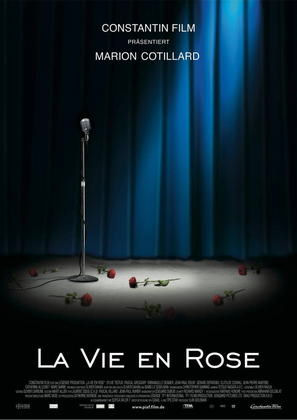
There’s no way to deliver the kind of upbeat-ending finales that Ray and Walk The Line had when your subject winds up dead from morphine addiction and other lifelong abuses (and looking like death itself at the end), but the spirit of this enterprise is so fierce and trembling that using the word “downer” would be grossly off-the-mark.
I could pass along the plot particulars and describe the numerous secondary characters and raise a glass to each and every performer, but I’m not going to. Everything significant in Piaf’s Wikipedia biography has been rendered on the screen, and if you want to know the story before seeing the film, go for it.
Suffice that all the performances have a finely rendered, steeped-in-conviction quality. Gerard Depardieu‘s Louis Leplee, the Parisian nightclub owner who discovered Piaf, and Jean-Pierre Marin‘s Marcel Cerdan, the great love of Piaf’s life, are the best of the lot.
I was also taken with Catherine Allegret‘s performance as Louise, a Normandy brothel-runner who helped raise Piaf as a very young girl. (My first thought was how much Allegret resembles Simone Signoret; it was quite a mind-bender to read that she’s her daughter.)
Here’s a video clip of a scratchy old concert film clip of Piaf in the late 1950s. And here’s another one.

“La vie en rose” (i.e., “life through rose-colored glasses”) is said to be Piaf’s signature song, although I’ve always thought that “Non, je ne regrette rien” was a much fuller, on-target summation of who she was and how she dealt with the ups and downs.
Picturehouse acquired U.S . distrib rights o La Vie in Rose in Cannes last year, and will be pushing it for Best Foreign Language Feature, no question.
Cotillard “delivers one of the best female performance of the past decade,” a guy who wrote me from the Berlin Film Festival insisted last February. “She’s the Penelope Cruz-in-Volver of this calendar year, except she could have a serious shot at winning.” I don’t agree. At this stage of the game, Cotiilard seems like this year’s Helen Mirren. Is that overstating things? I’m not so sure that it is.
It’s not in the least bit significant that Cotillard is 5′ 6 and 1/2 inches, or nearly a full foot taller than Piaf, since almost no one watching this film is likely to know this or be aware of any height discrepancy anyway. But it is significant that everything she says and does as Piaf is a complete immersion, an exceptional revisiting…an absolute knockout.
Anderson on “Vacancy”
Variety critic John Anderson feels that the “substantive issue” to be taken with Vacancy, the Luke Wilson-Kate Beckinsdale homicidal- menace film from director Nimrod Antal (Kontroll), “is its reliance on inexplicable cruelty and viciousness.
“Seldom has criminal violence been so unabashedly used for entertainment, in a story in which the criminals are perpetrating violence to be sold as entertainment. It’s doubtful the filmmakers were intending to deliver an oblique moral argument against their own movie, but they did so all the same.”
That aside, Antal “proves himself an able director who has made a highly cinematic movie,” Anderson adds. “Shooter Andrzej Sekula‘s compositions are startling for a film of this ilk, the pace is appropriately brisk and everything clicks, at least visually. Antal may rely on closeups — and extreme closeups — more than anyone since Carl Dreyer, but what he creates is a sense that something is always looming just outside the strangulated frame. Whether it’s David Fox (Wilson), his bitterly estranged wife Amy (Beckinsale), or the crawlingly evil motel clerk Mason (Frank Whaley), neither they, nor viewers, ever seem to be alone.”
“Sahara” budget exposed
L.A. Times staffer Glenn Bunting got his hands on detailed budget documents for Sahara, a poor man’s Indiana Jones adventure flick with Matthew McConaughey, Penelope Cruz and Steve Zahn that came out in 2005 and lost at least $78 million despite having earned $122 million. That’s because it cost $160 million to make and racked up $81.1 million in distribution expenses. This makes it “one of the biggest financial flops in Hollywood history,” Bunting writes.
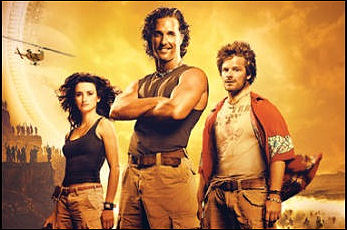
A story based on tangible black-and-white data and the usual verifying and follow-up calls, and Movie City News is calling Bunting’s story “gossip.”
The second I saw the above one-sheet with McConaughey trying to affect a brawny man-of-adventure vibe with his arms folded (i.e., to hide the fact that his arms are disproportionately short — three or four inches shorter and he would almost have Thalidomide-baby flipper arms) and flashing that second-rate-macho, cock-of-the- walk, men’s-cologne-commercial smile, I knew right away I wouldn’t go to the free screening and that I wouldn’t rent it on DVD. I decided that instantly. But now I want to see it because of Bunting’s piece.
“Movie budgets are one of the last remaining secrets in the entertainment business,” Bunting writes, “typically known to only high-level executives, senior producers and accountants. ‘The studios guard that information very, very carefully,’ said Phil Hacker, a senior partner in a Century City accounting firm that audits motion pictures. ‘It is a gossip industry. Everyone wants to know what everyone else is getting paid.'”
Among the tidbits and line items…..
(a) the fact that Sahara has technically lost about $105 million to date, according to a finance executive assigned to the movie, [although] records show the film losing $78.3 million based on Hollywood accounting methods that count projected revenue ($202.9 million in this case) over a 10-year period”;
(b) That among the 1,000 cast and crew members who worked on Sahara, “the highest-paid was McConaughey, who received an $8 million fee, or $615,385 for each week of filming, not including bonuses and other compensation. Cruz earned $1.6 million. Rainn Wilson, who since has raised his profile through roles in “Six Feet Under” and “The Office,” was paid $45,000 for 10 weeks of work.” Hey….what did Zahn make?
(c) a 46-second scene showing the crash of a vintage airplane, shot in London in 2003, cost more than $2 million but was never used in the final film. “In the context of the movie, it didn’t work,” said director Breck Eisner.
Boycott the Grove
This shot is out-of-focus ugly because I took it in a state of double duress. One, I was having a cardiac arrythmia attack due to a sudden realization that the Pacific Grove actually wanted $12.75 of my hard-earned money so I could see Disturbia. (I paid, but it felt really awful to shell out almost $13 to see a merely-acceptable thriller so I can reconsider Shia LeBouf.) And two, the ticket girl was saying to me, “Sir, you can’t take a picture of the board….sir! Sir!”

The Pacific Theatres execs who pushed this price-hike through late last year are delusional (they’re almost charging weekend Arclight prices, and the Grove is nothing close to the Arclight — it’s just another plex with stadium seating), odious and opportunistic (they’re basically piggy-backing on the Arclight-created public willingness to part with $13 or $14 bucks for a movie) and…I don’t know, can we throw in “evil” as well?
Go to the Arclight or the Bridge or to a play, or stay home and watch DVDs or YouTube instead, but boycott, boycott, boycott the Grove for this horseshit, and tell your friends. Wait…are the other theatres charging $12.75 on weekends also?
There’s no question, by the way, that Shia LeBeouf has “it.” Presence, focus, intelligence, discipline — a first-rate actor. No one knows what his role will be in Indy IV, but there’s no way anyone’s going to buy him as any kind of blood relation to Harrison Ford. If that’s the plan, I mean.
Apatow vs. Brazill
“I know it’s hard to believe that your rock band TV idea, which every writer in this town has thought of at one point, was not on my mind half a year after you told it to me. Yes, you thought of breaking the fourth wall. Groucho and George Burns stole it from you.
“Why don’t you sue the guys who have that new show How to Be a Rock Star on the WB? I must have told them your idea. Nobody has ever goofed on rock bands — not Spinal Tap or The Rutles or 800 Saturday Night Live sketches. I should have told everyone on the show, no rock band sketches, that’s Brazill’s area.
“So hold on to your hate and rage, even though it makes no sense. I’ll go back to my life of thievery and leeching. As for the cancer, I’ll wait till you get it and then steal it from you. By the way, that joke was one of my writers’, Rodney Rothman (see, I credited him). See, I have no original thoughts. Sorry I bothered to figure this out.” — a classic, possibly made-up 2002 e-mail argument between producer-director-writer Judd Apatow (Knocked Up) and producer-writer Mark Brazill, and published that same year in Harper’s.
A guy sent this to me yesterday. The first thing I did was laugh, and then I said to myself, “I’m not running this — you’re not supposed to be publish something that’s five days old these days, much less five years.” Then I figured “funny is funny” and fuck the late-publishing statute of limitations. For me, this thing almost neutralizes my Apatow resentments, which (as I’ve said at least three or four times before) are mainly about the grotesque first half of Apatow’s The 40 Year-Old Virgin (i.e., drunk girl spewing on Carell, nurse ripping off his chest hair, etc.)
Whitlock on Imus
Wow…this Jason Whitlock column (which ran in the Wednesday, 4.11 edition of the Kansas City Star) about the Don Imus brouhaha is perhaps the boldest eyeball-to-eyeball, take-it-or-leave-it view I’ve read about this whole mess so far.

The guy’s obviously a traditionalist-conservative of some sort, but he’s more or less saying the same thing I said a day earlier (Tuesday, 4.10), to wit: “It’s obviously malicious and insensitive to denigrate people in this fashion (or any fashion), but everyone is dumping on everyone else these days — why single out Imus? It’s a shitstorm out there.”
What follows is a portion of Whitlock’s column, but by all means read the whole thing:
“I ain’t saying Jesse Jackson, Al Sharpton and [Rutgers women’s basketball team coach] Vivian Stringer are gold-diggas, but they don’t have the heart to mount a legitimate campaign against the real black-folk killas.
“It is us. At this time, we are our own worst enemies. We have allowed our youths to buy into a culture (hip hop) that has been perverted, corrupted and overtaken by prison culture. The music, attitude and behavior expressed in this culture is anti-black, anti-education, demeaning, self-destructive, pro-drug dealing and violent.
“Rather than confront this heinous enemy from within, we sit back and wait for someone like Imus to have a slip of the tongue and make the mistake of repeating the things we say about ourselves.
“It’s embarrassing. Dave Chappelle was offered $50 million to make racially insensitive jokes about black and white people on TV. He was hailed as a genius. Black comedians routinely crack jokes about white and black people, and we all laugh out loud.
“I’m no Don Imus apologist. He and his tiny companion Mike Lupica blasted me after I fell out with ESPN. Imus is a hack. But, in my view, he didn’t do anything outside the norm for shock jocks and comedians. He also offered an apology. That should’ve been the end of this whole affair. Instead, it’s only the beginning. It’s an opportunity for Stringer, Jackson and Sharpton to step on victim platforms and elevate themselves and their agendas.
“In the grand scheme, Don Imus is no threat to us in general and no threat to black women in particular. If his words are so powerful and so destructive and must be rebuked so forcefully, then what should we do about the idiot rappers on BET, MTV and every black-owned radio station in the country who use words much more powerful and much more destructive?
“I don’t listen or watch Imus’ show regularly. Has he at any point glorified selling crack cocaine to black women? Has he celebrated black men shooting each other randomly? Has he suggested in any way that it’s cool to be a baby-daddy rather than a husband and a parent? Does he tell his listeners that they’re suckers for pursuing education and that they’re selling out their race if they do?”
Rich on Imus
“It’s possible that the only people in this whole sorry story who are not hypocrites are the Rutgers teammates and their coach, C. Vivian Stringer. And perhaps even Don Imus himself, who, while talking way too much about black people he has known and ill children he has helped, took full responsibility for his own catastrophic remarks and didn’t try to blame the ensuing media lynching on the press, bloggers or YouTube.
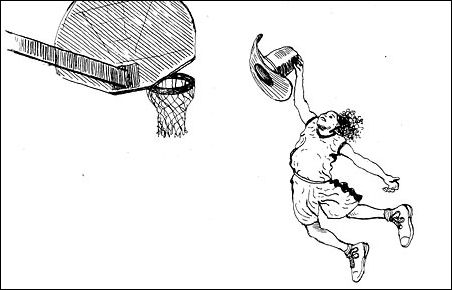
A N.Y. Times illustration by Barry Blitt that accompanies the Rich column
“Unlike Mel Gibson, Michael Richards and Isaiah Washington, to take just three entertainers who have recently delivered loud religious, racial or sexual slurs, Imus didn√ɬ¢√¢‚Äö¬¨√¢‚Äû¬¢t hire a p.r. crisis manager and ostentatiously enter rehab or undergo psychiatric counseling. ‘I dished it out for a long time,’ he said on his show last week, ‘and now it√ɬ¢√¢‚Äö¬¨√¢‚Äû¬¢s my time to take it.'” — from Frank Rich‘s 4.15.07 N.Y. Times column.
In all the hubbub I never looked at the YouTube clip of Imus committing his original sin. Rich’s article had the link.
“If…” trailer
Criterion is releasing a two-disc DVD of Lindsay Anderson‘s If…. on 6.19. And in tribute to this, Manhattan-based reader Chris Clark has slapped together a home-made trailer for it, hoping to “maybe drum up some interest for the first-time audience,” as he puts it.
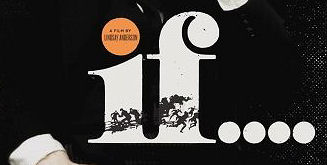
Released in 1968, If… “is a daringly anarchic vision of British society, set in a boarding school in late ’60s England,” the blurb reads. “Before Kubrick made his mischief iconic in A Clockwork Orange, Malcolm McDowell made a hell of an impression as the insouciant Mick Travis, who, along with his school chums, trumps authority at every turn, finally emerging as violent savior against the draconian games of one-upmanship played by both students and the powers that be.
“Mixing color and black-and-white as audaciously as it mixes fantasy and reality, If… remains one of cinema’s most unforgettable rebel yells.”

